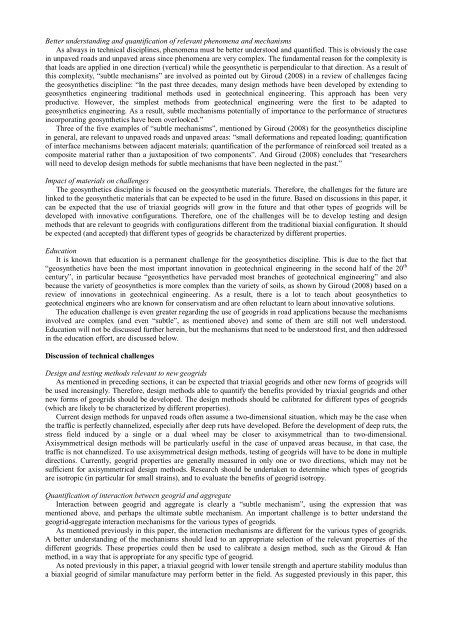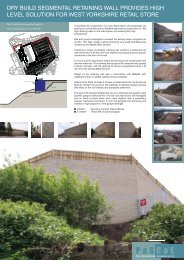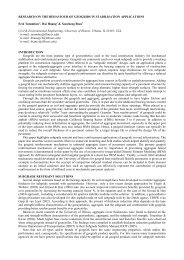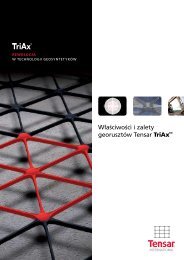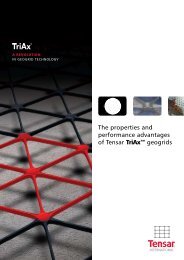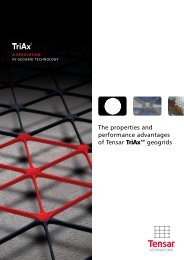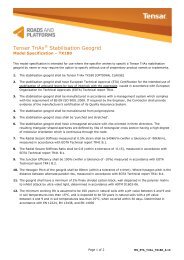3_JP Giroud_edited - Tensar International Ltd.
3_JP Giroud_edited - Tensar International Ltd.
3_JP Giroud_edited - Tensar International Ltd.
Create successful ePaper yourself
Turn your PDF publications into a flip-book with our unique Google optimized e-Paper software.
Better understanding and quantification of relevant phenomena and mechanisms<br />
As always in technical disciplines, phenomena must be better understood and quantified. This is obviously the case<br />
in unpaved roads and unpaved areas since phenomena are very complex. The fundamental reason for the complexity is<br />
that loads are applied in one direction (vertical) while the geosynthetic is perpendicular to that direction. As a result of<br />
this complexity, “subtle mechanisms” are involved as pointed out by <strong>Giroud</strong> (2008) in a review of challenges facing<br />
the geosynthetics discipline: “In the past three decades, many design methods have been developed by extending to<br />
geosynthetics engineering traditional methods used in geotechnical engineering. This approach has been very<br />
productive. However, the simplest methods from geotechnical engineering were the first to be adapted to<br />
geosynthetics engineering. As a result, subtle mechanisms potentially of importance to the performance of structures<br />
incorporating geosynthetics have been overlooked.”<br />
Three of the five examples of “subtle mechanisms”, mentioned by <strong>Giroud</strong> (2008) for the geosynthetics discipline<br />
in general, are relevant to unpaved roads and unpaved areas: “small deformations and repeated loading; quantification<br />
of interface mechanisms between adjacent materials; quantification of the performance of reinforced soil treated as a<br />
composite material rather than a juxtaposition of two components”. And <strong>Giroud</strong> (2008) concludes that “researchers<br />
will need to develop design methods for subtle mechanisms that have been neglected in the past.”<br />
Impact of materials on challenges<br />
The geosynthetics discipline is focused on the geosynthetic materials. Therefore, the challenges for the future are<br />
linked to the geosynthetic materials that can be expected to be used in the future. Based on discussions in this paper, it<br />
can be expected that the use of triaxial geogrids will grow in the future and that other types of geogrids will be<br />
developed with innovative configurations. Therefore, one of the challenges will be to develop testing and design<br />
methods that are relevant to geogrids with configurations different from the traditional biaxial configuration. It should<br />
be expected (and accepted) that different types of geogrids be characterized by different properties.<br />
Education<br />
It is known that education is a permanent challenge for the geosynthetics discipline. This is due to the fact that<br />
“geosynthetics have been the most important innovation in geotechnical engineering in the second half of the 20 th<br />
century”, in particular because “geosynthetics have pervaded most branches of geotechnical engineering” and also<br />
because the variety of geosynthetics is more complex than the variety of soils, as shown by <strong>Giroud</strong> (2008) based on a<br />
review of innovations in geotechnical engineering. As a result, there is a lot to teach about geosynthetics to<br />
geotechnical engineers who are known for conservatism and are often reluctant to learn about innovative solutions.<br />
The education challenge is even greater regarding the use of geogrids in road applications because the mechanisms<br />
involved are complex (and even “subtle”, as mentioned above) and some of them are still not well understood.<br />
Education will not be discussed further herein, but the mechanisms that need to be understood first, and then addressed<br />
in the education effort, are discussed below.<br />
Discussion of technical challenges<br />
Design and testing methods relevant to new geogrids<br />
As mentioned in preceding sections, it can be expected that triaxial geogrids and other new forms of geogrids will<br />
be used increasingly. Therefore, design methods able to quantify the benefits provided by triaxial geogrids and other<br />
new forms of geogrids should be developed. The design methods should be calibrated for different types of geogrids<br />
(which are likely to be characterized by different properties).<br />
Current design methods for unpaved roads often assume a two-dimensional situation, which may be the case when<br />
the traffic is perfectly channelized, especially after deep ruts have developed. Before the development of deep ruts, the<br />
stress field induced by a single or a dual wheel may be closer to axisymmetrical than to two-dimensional.<br />
Axisymmetrical design methods will be particularly useful in the case of unpaved areas because, in that case, the<br />
traffic is not channelized. To use axisymmetrical design methods, testing of geogrids will have to be done in multiple<br />
directions. Currently, geogrid properties are generally measured in only one or two directions, which may not be<br />
sufficient for axisymmetrical design methods. Research should be undertaken to determine which types of geogrids<br />
are isotropic (in particular for small strains), and to evaluate the benefits of geogrid isotropy.<br />
Quantification of interaction between geogrid and aggregate<br />
Interaction between geogrid and aggregate is clearly a “subtle mechanism”, using the expression that was<br />
mentioned above, and perhaps the ultimate subtle mechanism. An important challenge is to better understand the<br />
geogrid-aggregate interaction mechanisms for the various types of geogrids.<br />
As mentioned previously in this paper, the interaction mechanisms are different for the various types of geogrids.<br />
A better understanding of the mechanisms should lead to an appropriate selection of the relevant properties of the<br />
different geogrids. These properties could then be used to calibrate a design method, such as the <strong>Giroud</strong> & Han<br />
method, in a way that is appropriate for any specific type of geogrid.<br />
As noted previously in this paper, a triaxial geogrid with lower tensile strength and aperture stability modulus than<br />
a biaxial geogrid of similar manufacture may perform better in the field. As suggested previously in this paper, this


